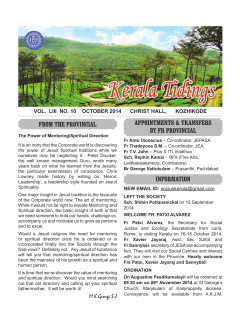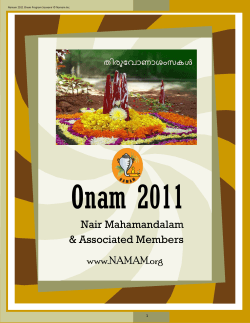
How to make an Onam Pookalam?
How to make an Onam Pookalam? A traditional flower arrangement made during the festival of ‘Onam’ in Kerela, India. Instructional Writing • Narrative & Argument 2012 • Shiba Sheikh What is Onam? Onam is a festival celebrated by the Hindu’s in Kerela, India. It celebrates the rice harvest season and falls in the month of August- September and lasts for a period of ten days. It commemorates the homescoming of the native emperor ‘Mahabali’. Legend has it that it is under his reign that the people of the kingdom were most prosperous. It was considered to be the golden era. Onam is marked to be the most important and vibrant festival of the state of Kerela. The key highlights of the festivals is the Vallamkali (Snake boat race), Onasadya ( 9 course meal on a banana leaf ) and the Pookalam ( Intricate flower carpet made in front of the courtyard to welcome the Mahabali). * What is an Onam Pookalam? An ‘Onam Pookalam’ is a intricately designed carpet of flowers that is made usually in the courtyard of a house or at the entrance on the final day of the Onam celebrations. The first day ‘Atham’ is when the arrangement begins to take shape and by the tenth day ‘Thiruonam’, it becomes more complex and detailed. ‘Pookalam’ can be broken into ‘Poov’flower and ‘kalam’- color sketches on the ground. Tradition has it that young adolescent girls of the household make the Onam Pookalam to welcome Mahabali. Onam Pookalam requires team effort, technique and kilos of flower petals and leaves to create. They are usually circular in shape and vary in size from 2 to 4 meters in diameter. The arrangement begins to take form on the first day and as the days of the festival gain momentum, the grandeur of the Pookalam increases in size and complexity of design. Fragrant ‘thumba’ flowers (white) are predominantly used to create the design as they radiate the sunlight in the morning hours. Creating the Onam Pookalam is the most auspicious and significant event of the festivities that surround Onam. But over a period of time the trends of creating them have evolved. Earlier, children would wake up early in the morning and walk around the neighborhood with baskets collecting flowers that were naturally found in the region. But now in cities, people prefer visiting flower markets the previous day and preserve the flowers in refrigerators and then use them. The Onam Pookalam is wonderful example of traditions that bring the family together and represent the growing change in ways in which the new generations adapts to age old traditions. Here is a detailed friendly guide to what will help you make your own ‘Onam Pookalam’. METHOD Materials required to create a 2 meter diameter ‘Onam Pookalam’ 500 gm of Yellow Marigold 250 gm of Orange Marigold 100 gm Gromphera/ Adike Hoovu 20 leaves of Gulmohar tree 250 gm Purple Aster 500 gm White Chrysanthamum 1 Brass Lamp Few Tea Candles STEP 1 Seperate the petals from the flowers. Having once acquired the basic ingredients from the flower market, the first step to take care of is to gently seperate the petals from the flowers and place them on either old newspaper or a sheet of plastic, seperately without mixing them. Tip - Take gentle care whilst seperating the petals from the flower. You don’t want them to break as they will darken faster. Avoid keeping them under direct sunlight and store them in the cooler reagion of the house preferably. It is a long tedious process hence find family and friends to help! STEP 2 The Pookalam Design The Pookalam design is the most integral bit to tackle. The best way to start is with a paper and pencil and roughly outline what is it that you are envisioning. Few design elements that are commonly used and then integrated with the circular pattern is of a leaf, geometric forms and flowers. Draw them out seperately and then well pull them right into the design. Lets begin with a circle that is split in 8 to 16 equal parts. Create further smaller circles within to create multiple layers. This will give you the basic grid to work with. Now play around with the nodes created at the insection of each arc to make forms of leaves and flowers as shown above in the image. Work with one section of the arc and then repeat the same pattern all around. The design will automatically emerge. Tip - To start with, it helps to work with tracing paper or butter paper. You can iterate over and over your design without having to recreate it every single time. Work on your design a couple of days before the final day of execution. As it will give you time to revise your design and scale. STEP 3 Drawing the design on the floor Once the design is ready on paper, the next big challenge is to translate it onto the surface it is going to be created on. The tools that we use while drawing on paper is different from the ones we use when we draw on the floor. Use a chalk or a crayon to draw on the floor. Begin by filling in only one section of the arc and then replicating the same design all around. Once the pattern is laid out you can begin to imagine the placement of different colored flowers. The ones that were listed in the ingredients section are the basic traditional set always used. You can try placing a few petals next to each other to see what color contrast works for you and the surface your working with. Once you have a better idea we can begin with the next step. Tip - It helps to wet the chalk before use. It is easier to wipe off while drawing incase of any error. In the olden days it said that families laid a layer of cow dung on the mud surface before creating the flower carpet. The cow dung acted as a binder to hold the layer of petals together. STEP 3 Start from the centre Once the design is ready its time to fill it in with our key ingredients. The flower petals can now be brought out and you can begin to fill it in. Always begin from the centre and then work your way outwards. The same way you drew your pattern on the floor, fill in one arc at a time and then make your way around the rest of the circle. Always fill the design in two parts. First lay a very thin layer of petals to guage the exact amount needed to fill in the individual sections of the pattern and then fill the second layer in to add volume depending on the amount of raw materials available. Pat the petals gently while you keep filling in individual sections to pack them without being too harsh and crushing them. It also helps maintain clear boundaries and let the colors mix. Tip - Once you finish the first arch you will have a better idea of the color pattern working or not. This is the ideal time to either change or redo in case you feel like it is not working. Avoid disturbing the arrangement more than once or twice as the petals will begin to darken and shrivel. STEP 4 Fill it out Once the first arch is sucessfully filled out and you are satisfied with the color contrast and the design fill the rest of the design out gently. This is when having a multiple set of hands helps as people can work simultaneously on the design. The process is much more effective if carried out during the early hours of the day before the suns rays get too harsh. The flower petals tend to remain much more fresh and crisp and fill the air with a sweet fragrance that everyone can wake upto. Tip - When multiple people are laying out the flower arrangement it is important to maintain the volume of petals beings filled up in individual sections to get an even layer without visible bumps and chunks of petals sticking out . The idea is to achieve an even carpet like design. If you do notice prominent lumps you can scoop them out either with your hands or a spoon gently. STEP 5 Final touches Once the design is completely filled in and finished its time for the finishing touches. With a sharp object like a knife or even a slender wooden stick carve out individual sections once again in order to create distinct and clear divisions. Sometimes over the period of filling the design up the mass of petals tend to collapse or mix. You can even individually clear and clean out sections that you might feel are loosing shape. It helps to gently pat whilst filling the petals and leaves in, into a slight bulbous form to keep it intact. After having finished the design is the right time to place the brass lamp and tea lights at points you feel will highlight the design. Tip - Some people place the lantern right in the centre and light it first and then begin to fill the design out. Since the brass lamp is fueled with oil or clarified butter it burns for a very long time and you can avoid the possibility of breaking the design after finishing it. Even much after the design is completed and then place the tea lights along the edges. We are done! Hope the instructions provided will sucessfully help you in creating your own ‘Onam Pookalam’ design. The image above shows a traditional design that is layed out with flower petals, leaves, a brass lamp and tea light or diyas. As intricate and complicated the design may seem, once you follow the process step by step you will also be able to achieve the same results in no time. Why wait for Onam? Instead try your hand at decorating your home with your original creation of the ‘Onam Pookalam’!
© Copyright 2025












